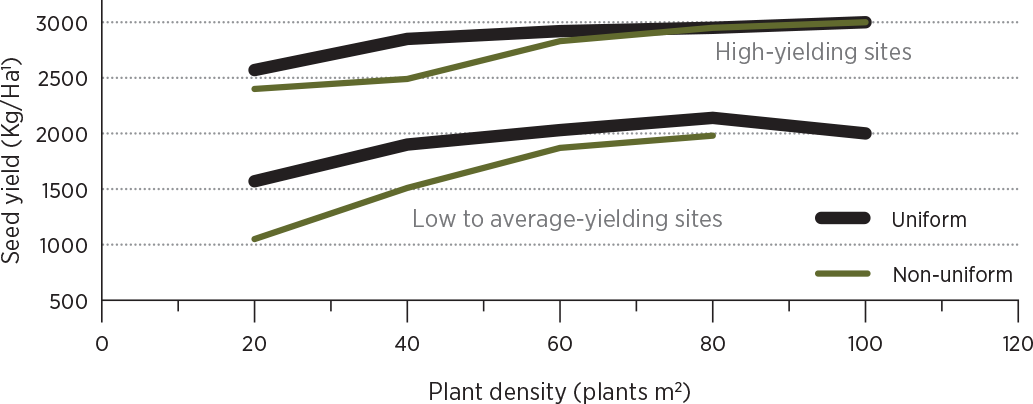More plants, more yield
Canola yield increases as plant population increases, according to this study. As plant population went from 20 plants per square meter up to 100 per square meter, yield also increased at all site years.
Uniform plant stand is also important, especially for low plant populations, this study found. (See Figure 1.) Overall, uniform planting produced 14 percent greater seed yield than non-uniform planting at low- to average-yielding sites when plant density was at or below 80 plants per square meter (roughly eight per square foot). At high yielding sites, uniform and non-uniform plantings resulted in similar seed yield — as long as plant density was greater than 60 plants per square meter.
Yantai Gan with Agriculture and Agri-Food Canada (AAFC) in Swift Current led a three-year study to determine the effect of various degrees of seeding uniformity and non-uniformity on canola plant establishment and seed yield in various soil-climatic zones. In 2010, experiments were conducted at five sites: Swift Current, SK, Melfort, SK, Carman, MB, Brandon, MB and Lacombe, AB. In 2011 and 2012, the sites were Swift Current, SK, Melfort, SK, Indian Head, SK, Carman, MB, Morden, MB and Lacombe, AB.
The experiment compared uniform and non-uniform plant establishment for plant stands of 100, 80, 60, 40 and 20 plants per square meter. Plant stands were hand-thinned at the three-leaf stage to create uniform and non-uniform plant stands.

SEED VIGOUR AND STRAW MANAGEMENT
Study 3.1.4 included a second experiment to evaluate the effect of seed vigour and straw management options on plant establishment and crop yield in canola. It compared four residue management options: (1) 20-30 cm standing stubble, (2) 40 cm tall stubble with a spring mow to less than 5 cm, (3) shorter than 10 cm stubble with straw chopped, and (4) shorter than 10 cm stubble with straw removed.
The effect of straw management options on canola establishment and seed yield was inconsistent across the different sites and years. However, some specific effects did show consistent results.
In particular, option (3) decreased soil temperature during seedling emergence, slowed the initiation of flowering, and delayed maturity of canola compared with other management methods, particularly in Swift Current and Carman.
As for weed management, taller stubble patterns reduced the number of broadleaf weeds, and option (4) had the lowest ability for inhibiting grassy weeds.
The second experiment also compared three seed vigour options: (1) 120 high-vigour seeds per square meter, (2) 120 low-vigour seeds per square meter, and (3) a blend of 80 high-vigour seeds and 40 low-vigour seeds per square meter. Generally, the results showed that high-vigour seed promoted the speed of seedling emergence, improved plant growth, and increased canola seed yield. However, seed vigour had an inconsistent effect on plant maturity. Nonetheless, use of high-vigour seed does not mean producers should reduce their seeding rate.
Principal investigator: Yantai Gan, Agriculture and Agri-Food Canada,
Swift Current, SK
Collaborators: Neil Harker, Byron Irvine, Eric Johnson, Randy Kutcher,
Bill May, Guy Lafond, and Rob Gulden




